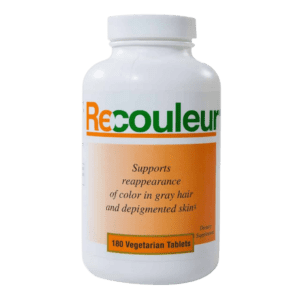We know vitiligo from the inside out. That’s why we’ve developed a daily supplement that has everything you need to support your skin and encourage the reappearance of pigmentation. Bring color back into your life with Recouleur®.
Tyrosine to melanin pathway
Pigment (melanin) is made by specialized cells (melanocytes). Pigment made in melanocytes is transferred to cells of the skin or hair.
In a functioning melanocyte, melanin is synthesized and packaged in pigment organelles called melanosomes. A single melanocyte supplies melanosomes to its group of 36 associated keratinocytes. Melanosomes are transferred via dendrites (extensions) of the melanocyte.
A reservoir of melanocytes exists in hair follicles. When the hair follicular melanocytes are activated, hair and skin pigment. Thus a greater number of melanocytes present cause a greater pigmentation.
In the presence of the active agent in the vehicle stimulates the proliferation of melanocyte cells thus causing pigmentation of the skin surface and hair.
Melanin synthesis occurs within the melanosomes in the presence of the oxidative enzyme tyrosinase, which converts tyrosinase to dihydroxyphenylalaline (DOPA) and subsequently to DOPAquinone. Tyrosinase requires copper for oxidation of tyrosine to dopa. Tyrosinase (and other members of the tyrosinase protein family) contains two atoms of copper per molecule. Furthermore, copper must be transported into the melanocytes and the melanosomes for their function. Copper requires the presence of pantothenic acid in order to be absorbed.
Hypopigmentation of the skin and hair in humans and animals results from local defects in the melanin production within the melanocyte. It is now possible without harmful side effects to achieve normalization of hypopigmentation. Furthermore, it is now possible to achieve darkening of graying hair.
Synthesis of melanin within a melanocyte is controlled by the activity of an enzyme, tyrosinase, which is localized in an intracellular organelle – the premelanosome. Upon activation of tyrosinase, melanin is deposited with the organelle. After complete melanization, the premelanosome is known as a melanosome. Melanosomes are delivered to surrounding keratinocytes of the skin cells within the shaft of the graying hair by the process known as cytocrine secretion.
Folic acid contains three components:
- pteridine
- para-aminobenzoic acid
- L-glutamic acid.
Free pteridine is the coenzyme for the enzymatic hydroxylation of phenylalanine to tyrosine. Thus a deficiency in pteridine causes a deficiency in tyrosine.
Para-aminobenzoic acid (PABA) (a component of folic acid) is needed for melanogenesis. PABA helps in the utilization of pantothenic acid. Thus folic acid in its whole is more effective than administering some of its parts in stimulating/ supporting/ feeding pigment production.





